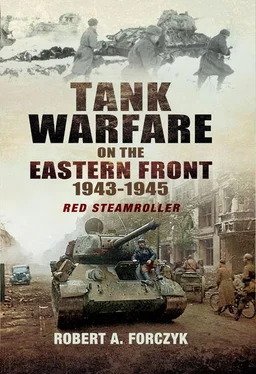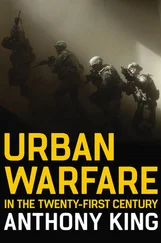Nevertheless, the annual output of tens of thousands of even partly-trained tankers was one of the great wartime miracles of the Soviet Union and helps to explain why the Red Army gradually gained the upper hand. Yet it was a frightfully wasteful method of replacing personnel losses, and had the Red Army built even a single modern gunnery training facility like Putlos and a manoeuvre training area like Grafenwöhr, Soviet tank losses would have dropped significantly and greater losses would have been inflicted on the Germans. Indeed, lack of attention to quality training constituted a self-inflicted wound for the Red Army, which was not resolved during the war. The Soviet Communist approach to warfare was driven by industrial imperatives, not concern for the well being of the ‘little cogs’ at the front.
Soviet Tank Production and Lend-Lease
Initially, Stalin had selected Vyacheslav Malyshev, an engineer with great experience expanding Soviet heavy industry in the Five Year Plans, as his People’s Commissar of the Tank Industry (NKTP). Malyshev had worked wonders during the industrial evacuations of 1941 and jump-starting tank production at Chelyabinsk and Nizhniy Tagil. However, Malyshev was more of an industrial manager and had no direct experience with designing armoured vehicles. In July 1942, Stalin had decided to replace Malyshev as NKTP with Isaac M. Salzman, the former director of the Kirov plant in Leningrad. Salzman was certainly more knowledgeable about tanks, but he was also involved in the rivalries between the three primary Soviet tank design bureaux and he tended to favour engineers and designs that originated from the Kirov group. During Salzman’s tenure, T-34 production hit its highest mark in December 1942, with 1,568 units built. However, Salzman was directed by the NKO not to effect any major changes in existing tank designs that could reduce production output, and the same went for trying to develop new tanks. Consequently, a certain inertia and stagnation settled into the Soviet tank industry on Salzman’s watch, even though he was discouraged from taking proactive steps to match advances in German tank technology.
Thanks to the efforts of both Malyshev and Salzman, Soviet industry was able to expand tank production to outstrip Germany’s industrial output. Automatic welding techniques were introduced to speed up assembly-line procedures. Additionally, constant efforts to cut corners resulted in reducing the man hours required to manufacture a single T-34 tank from 5,300–9,000 hours in early 1942 to 3,700–7,200 hours by January 1943. {45} The Nizhniy Tagil factory (renamed the Stalin Ural Tank Factory 183) achieved the greatest efficiencies in tank production and was building nearly half of all T-34s. However, the emphasis upon reducing labour input for tank production – although statistically pleasing to Soviet labor officials – resulted in a serious decline in the quality of tanks being built. The new cast turret, introduced in late 1942, was plagued with fractures and the hulls produced at Nizhniy Tagil and Sverdlovsk also had a high rate of cracks. Even the heretofore reliable V2 diesel engine suffered an increased rate of failures and tests in 1942 indicated that the mean-time-between-failure for the engine was 200–300km instead of the design specification of 1,000km. {46} Consequently, the Soviet tanks that were used in the early campaigns of 1943 tended to be less mechanically reliable, particularly with crews that were ignorant about preventative maintenance.
It is important to note that while Soviet industry was able to consistently out-produce the German tank industry, the Soviet Union only had one front to worry about and its tank factories were not being bombed. Nor did the Soviet Union have to divert steel to naval production, while Germany expended considerable industrial resources in 1942–44 in building up its U-Boat fleet. Furthermore, in order to boost tank production in 1941–42, the Soviets had to convert one of their primary truck factories, GAZ, to manufacturing light tanks. Consequently, Soviet domestic production of trucks was significantly less than that of Germany and the difference was only made up by Lend-Lease. The situation was even worse in terms of armoured halftracks (see Table 1), which were essential for employing mechanized infantry in fast-moving armoured formations. The Soviet Union never developed a vehicle that was analogous to the German SPW and relied entirely upon a small number of U.S.-built M2 halftracks and M3A1 scout cars to outfit the mechanized infantry in a few chosen Guards units. None of the Soviet mechanized infantry units in 1943 were fully motorized and were forced to use the expedient of Desant (landing), whereby at least one battalion in each brigade rode atop tanks. Thus while outnumbered in terms of tanks, German mechanized units retained a significant edge in motorization over the Red Army until mid-1944, when the balance finally shifted in favour of the Soviets.
Table 1 : Comparison of Halftrack and Truck Production, 1943–44

Lend-Lease also continued to provide important augmentation to the Red Army’s tank strength in 1943–44. During 1943, the Soviet Union received another 2,995 Lend-Lease tanks from the Western Allies: 2,102 from the British (1,776 Valentine, 179 Churchill and 147 Matilda) and 893 from the United States (469 M4A2 Sherman, 260 M3/M5 Stuart and 164 M3 Lee). {47} In addition, the Soviets received 41 M31s, an armoured recovery vehicle based on the Lee tank, for which they had no equivalent. Although the Soviets often complained about the quality of Lend-Lease tanks, the Shermans and Valentines both proved reliable and were retained in service to the end of the war.
Although Soviet armoured fighting vehicle production exceeded that of Germany, few realize that it essentially hit its ceiling in late 1942–early 1943. Afterwards, the introduction of any new design such as the T-34/85 and IS-2 significantly impacted production. The NKO was considering an upgraded version of the T-34 tank and was interested in a new heavy tank to replace the KV-1, but was unwilling to divert resources to these efforts while the Germans were still reeling from the Stalingrad debacle. The one area where the NKO gave Salzman some leeway was on the SU programme, since it wanted to replace the T-70 light tank with a better-armed vehicle. Salzman put one of his engineers from the old OKMO design bureau, Semyon A. Ginzburg, in charge of developing the SU-76 self-propelled gun. General-polkovnik Nikolai D. Yakovlev’s Main Artillery Directorate provided the 76.2mm ZIS-3 gun for the new vehicle. Using a lengthened T-70 chassis, Ginzburg designed a lightly-armoured housing for the ZIS-3 gun atop the hull and had a prototype ready in December 1942. Salzman approved the prototype for limited production without trials and the first SU-76 were built before the end of 1942. In January 1943, a few of these SU-76 were sent to the Volkhov Front, where they proved to be a complete failure. The T-70’s two GAZ-202 truck engines had been adequate to move the T-70 light tank, but the addition of an extra ton of weight was too much and the SU-76 was difficult to steer and its transmission was inadequate. A clear sign that the vehicle was underpowered was the high number of final drive failures. Salzmann and Ginzburg tried to fix the design problems of the SU-76, but this caused production to cease in April 1943.
Unlike Hitler, Stalin did not tolerate engineering failure and after six months of Ginzburg’s fumbling with the SU-76 project, Stalin issued GKO Decree 3530ss on 7 June 1943, which stated that:
The State Committee of Defence [GKO] decrees that the SU-76 self-propelled guns, designed by comrade Ginzburg of the People’s Commissariat of Tank Production [NKTP], and accepted by GOKO decree No.2559 on December 2, 1942, turned out to be of unsatisfactory quality. Furthermore, the NKTP (comrade Saltzman) and GAU KA (comrade Yakovlev) did not carry out trials with due diligence before accepting the SU-76 for production. The modifications proposed by the NKTP (comrade Saltzman) and GAU KA (comrade Yakovlev), confirmed by GOKO decree #3184ss on April 14, 1943, did not result in serious improvements and did not increase the quality of the SU-76 to satisfactory levels, which also suggests that the NKTP and GAU KA trials were executed poorly.
Читать дальше









![John Stieber - Against the Odds - Survival on the Russian Front 1944-1945 [2nd Edition]](/books/405234/john-stieber-against-the-odds-survival-on-the-russian-front-1944-1945-2nd-edition-thumb.webp)



